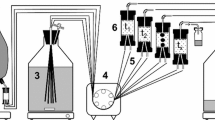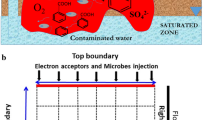Abstract
To date, evidence for the degradation of benzene under anaerobic conditions has been established only in few studies under field and laboratory conditions. Recently, we demonstrated the mineralization of benzene under sulfate-reducing conditions in a large-scale column experiment at a field site by balancing electrons (Vogt et al. in Biodegradation, 2007, in press). Here, from a modelling approach, kinetic Monod parameters are estimated for the degradation of benzene in the columns, Monod kinetics proved useful to simulate benzene concentrations at the column outflow. The uncertainty of the obtained parameters is determined in a sensitivity analysis. A total mass of degraded benzene of 23 g or 80% of the total influx over a period of three months was calculated. The estimated maximum utilization rate was calculated to be around 70 times lower than from aerobic benzene degradation experiments.











Similar content being viewed by others
References
Alfreider A, Krössbacher M, Psenner R (1997) Groundwater samples do not reflect bacterial densities and activity in subsurface systems. Water Res 31(4):832–840
Anderson RT, Lovley DR (2000) Anaerobic bioremediation of benzene under sulfate-reducing conditions in a petroleum-contaminated aquifer. Environ Sci Technol 34:2261–2266
Burland SM, Edwards EA (1999) Anaerobic benzene biodegradation linked to nitrate reduction. Appl Environ Microbiol 65:529–533
Chapelle FH, Bradley PM, Lovley DR, O’Neill K, Landmeyer JE (2002) Rapid evolution of redox processes in a petroleum-contaminated aquifer. Groundwater 40(4):353–360
Clement TP (1997) RT3D—A modular computer code for simulating reactive multispecies transport in 3-dimensional groundwater systems. [1.0]. Battelle Pacific Northwest Laboratory
Clement TP, Sun Y, Hooker BS, Petersen JN (1998) Modeling multispecies reactive transport in groundwater. Groundwater Monit Remediat 18(2):79–92
Clement TP, Kim YC, Gautam TR, Lee KK (2004) Experimental and numerical investigation of DNAPL dissolution processes in a laboratory aquifer model. Groundwater Monit Remediat 24(4):88–96
Da Silva MLB, Alvarez PJJ (2004) Enhanced anaerobic biodegradation of benzene-toluene-ethylbenzene-xylene ethanol mixtures in bioaugmented aquifer columns. Appl Environ Microbiol 70(8):4720–4726
Davis C, Cort T, Dai D, Illangasekare TH, Munakata-Marr (2003) Effects of heterogeneity and experimental scale on the biodegradation of diesel. Biodegradation 14:373–384
DIN 38409-7 (1979) Bestimmung der Säuren- und Basenkapazität
Edwards EA, Grbic-Galic D (1992) Complete mineralization of benzene by aquifer microorganisms under strictly anaerobic conditions. Appl Environ Microbiol 58(8):2663–2666
Eisermann D (2005) Reaktive Transportmodellierung am Safira Standort Bitterfeld. PhD Thesis, University of Leipzig, Germany
Fischer A, Bauer J, Meckenstock R, Stichler W, Griebler C, Maloszewski P, Kästner M, Richnow HH (2006) A multitracer test proving the reliability of stable isotope fractionation analysis for assessing anaerobic degradation in a BTEX contaminated aquifer. Environ Sci Technol 40:4245–4252
Gödeke S, Weiß H, Richnow HH, Fischer A, Vogt C, Borsdorf H, Schirmer M (2006) Multispecies-reactive tracer test for the implementation of enhanced in situ bioremediation at a BTEX contaminated megasite. J Contam Hydrol 87(3–4):211–236
Grbic-Galic D, Vogel TM (1987) Transformation of toluene and benzene by mixed methanogenic cultures. Appl Environ Microbiol 53:254–260
Ilic B, Craighead HG, Krylov S, Ober C, Neuzil P (2004) Attogram detection using nanoelectromechanical oscillators. J Appl Phys 95:3694–3703
Kazumi J, Caldwell ME, Suflita JM, Lovley DR, Young LY (1997) Anaerobic degradation of benzene in diverse anoxic environments. Environ Sci Technol 31:813–818
Kopinke F-D, Georgi A, Mackenzie K (2001) Sorption of pyrene to dissolved humic substances and related model polymers part 1: structure–property correlation. Environ Sci Technol 35:2536–2542
Lehmann RM, Colwell FS, Bala GA (2001) Attached and unattached microbial communities in a simulated basalt aquifer under fracture- and porous-flow conditions. Appl Environ Microbiol 67(6):2799–2808
Lovley DR, Woodward JC, Chapelle FH (1994) Stimulated anoxic biodegradation of aromatic hydrocarbons using Fe (III) ligands. Nature 370:128–131
Lovley DR, Coates JD, Woodward JC, Phillips EJP (1995) Benzene oxidation coupled to sulfate reduction. Appl Environ Microbiol 61(3):953–958
Mackenzie K, Georgi A, Kumke M, Kopinke F-D (2002) Sorption of pyrene to dissolved humic substances and related model polymers part 2: solid-phase microextraction (SPME) and fluorescence quenching technique (FQT) as analytical methods. Environ Sci Technol 36:4403–4409
Marr EK, Stone RW (1961) Bacterial oxidation of benzene. J Bacteriol 81:4245–4255
Meckenstock RU, Warthmann JR, Schäfer W (2004) Inhibition of anaerobic microbial o-xylene degradation by toluene in sulfidogenic sediment columns and pure cultures. FEMS Microbiol Ecol 47:381–386
Monod J (1949) The growth of bacterial cultures. Annu Rev Microbiol 3:371–394
Nales M, Butler BJ, Edwards EA (1998) Anaerobic benzene biodegradation: a microcosm survey. Bioremed J 2(2):125–144
Porter KG, Feig YS (1980) The use of DAPI for identifying and counting aquatic microflora. Limnol Oceanogr 25:943–948
Rifai HS, Rittaler T (2005) Modeling natural attenuation of BTEX with analytical and numerical models. Biodegradation 16(4):291–304
Riis V, Lorbeer H, Babel W (1998) Extraction of microorganisms from soil: evaluation of the efficiency by counting methods and activity measurements. Soil Biol Biochem 30(12):1573–1581
Sandrin SK, Brusseau ML, Piatt JJ, Bodour AA, Blanford WJ, Nelson NT (2004) Spatial variability of in situ microbial activity: biotracer tests. Groundwater 42(3):374–383
Schirmer M, Butler BJ, Roy JW, Frind EO, Barker JF (1999) A relative-least-squares technique to determine unique Monod kinetic parameters of BTEX compounds using batch experiments. J Contam Hydrol 37:69–86
Schirmer M, Molson JW, Frind EO, Barker JF (2000) Biodegradation modelling of a dissolved gasoline plume applying independed laboratory and field parameters. J Contam Hydrol 46:339–374
Schirmer M, Richnow HH, Gödeke S, Schirmer K, Weiß H, Dahmke A, Teutsch G (2006) Natural attenuation research at the contaminated megasite Zeitz. J Hydrol 328(3–4):393–407
Schreiber ME, Bahr JM (2002) Nitrate-enhanced bioremediation of BTEX-contaminated groundwater: parameter estimation from natural-gradient tracer experiments. J Contam Hydrol 55:9–56
Suarez MP, Rifai HS (1999) Biodegradation rates for fuel hydrocarbons and chlorinated solvents in groundwater. Bioremediat J 3(4):337–362
Vieth A, Kästner M, Schirmer M, Weiß H, Gödeke S, Meckenstock RU, Richnow HH (2005) In-situ biodegradation of benzene and toluene in a contaminated aquifer monitored by stable isotope fractionation. Environ Toxicol Chem 24(1):51–60
Vogt C, Gödeke S, Treutler HC, Weiß H, Schirmer M, Richnow HH (2007) Benzene oxidation under sulfate-reducing conditions in columns simulating in situ conditions. Biodegradation. doi:10.1007/s10532-006-9095-1 (in press)
Wachter Th, Dethlefsen F, Gödeke S, Dahmke A (2004) Räumlich-statistische Charakterisierung der Hydrogeochemie einer BTEX-Grundwasserkontamination am Standort „RETZINA”/Zeitz. Grundwasser 1(9):21–32
Wang S, Corapcioglu MY (2002) Simulation of bioaugmentation involving exogenous bacteria injection. Water Resour Res 38(12):1293. doi:10.1029/2001WR000344
Ward D M, et al (1980) Micobial biodegradation and chemical evolution of oil from the Amoco spill. Ambio 9:277–283
Wiedemeier TH, Rifai HS, Wilson JT, Newell C (1999) Natural attenuation of fuels and chlorinated solvents in the subsurface. Wiley, New York
Acknowledgments
Funding for the project has been provided through the SAFIRA (Remediation research in regionally contaminated aquifers) Programme of the UFZ Helmholtz Centre for Environmental Research. Additional funding has been provided by the German Federal Ministry of Education and Research (BMBF) under reference numbers 02WT0040, 02WT0041 and 02WT0042. We are grateful to Hans H. Richnow and Helmut Geistlinger (both UFZ) for their valuable advice during the experiments and the modelling. We thank Holger Weiß, Ralf Trabitzsch (both UFZ) and Olaf Böhme (GFE-Consult GmbH, Halle, Germany) for continuing support. We thank Werner Kletzander and Jörg Ahlheim (both UFZ) for technical assistance. We would also like to thank the Landesanstalt für Altlastenfreistellung, the Mitteldeutsche Sanierungs- und Entsorgungsgesellschaft mbH and the Zeitzer Standortgesellschaft mbH for their support. Finally, we thank an anonymous reviewer for his/her constructive comments.
Author information
Authors and Affiliations
Corresponding author
Rights and permissions
About this article
Cite this article
Gödeke, S., Vogt, C. & Schirmer, M. Estimation of kinetic Monod parameters for anaerobic degradation of benzene in groundwater. Environ Geol 55, 423–431 (2008). https://doi.org/10.1007/s00254-007-0988-z
Received:
Accepted:
Published:
Issue Date:
DOI: https://doi.org/10.1007/s00254-007-0988-z




